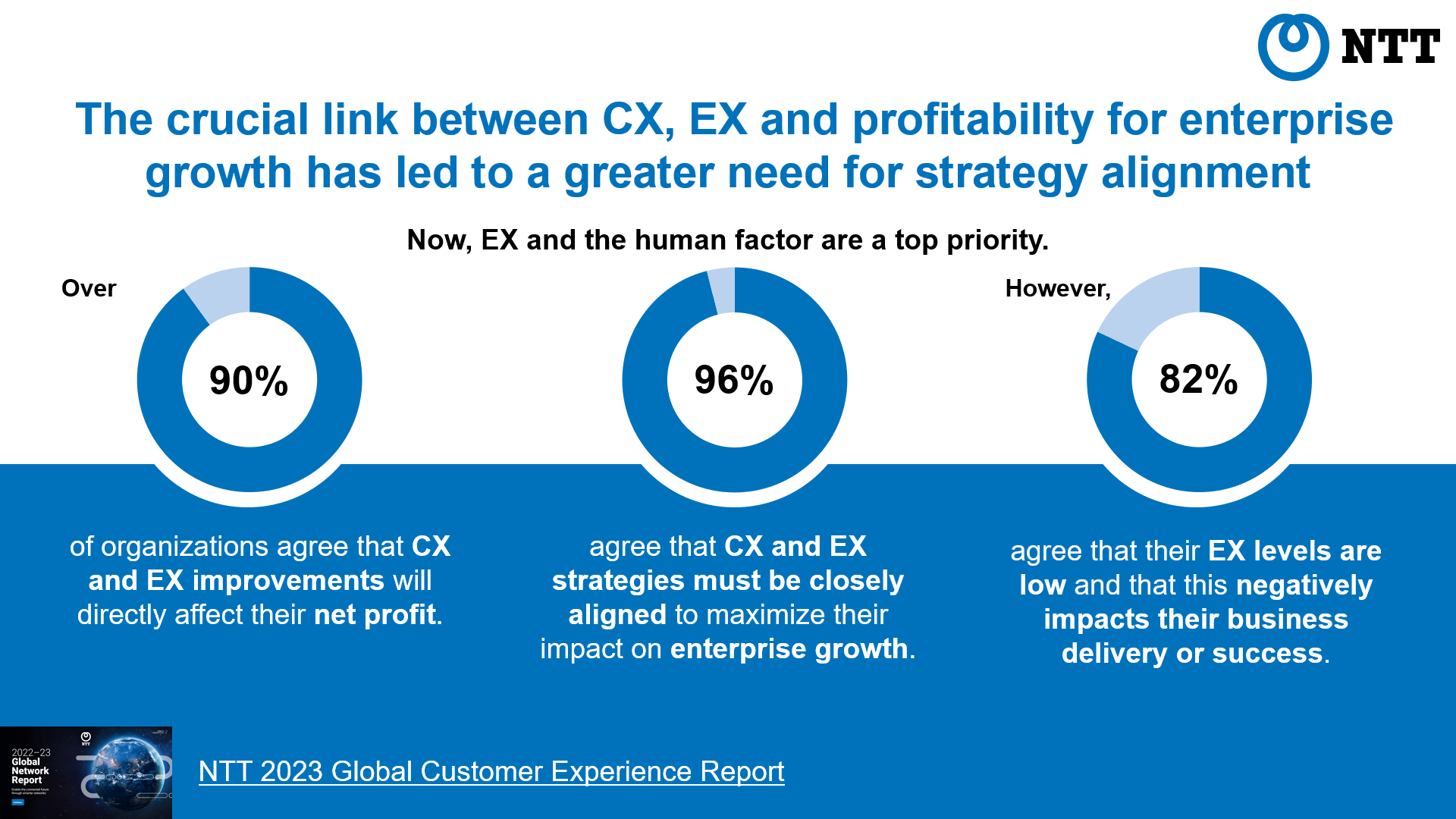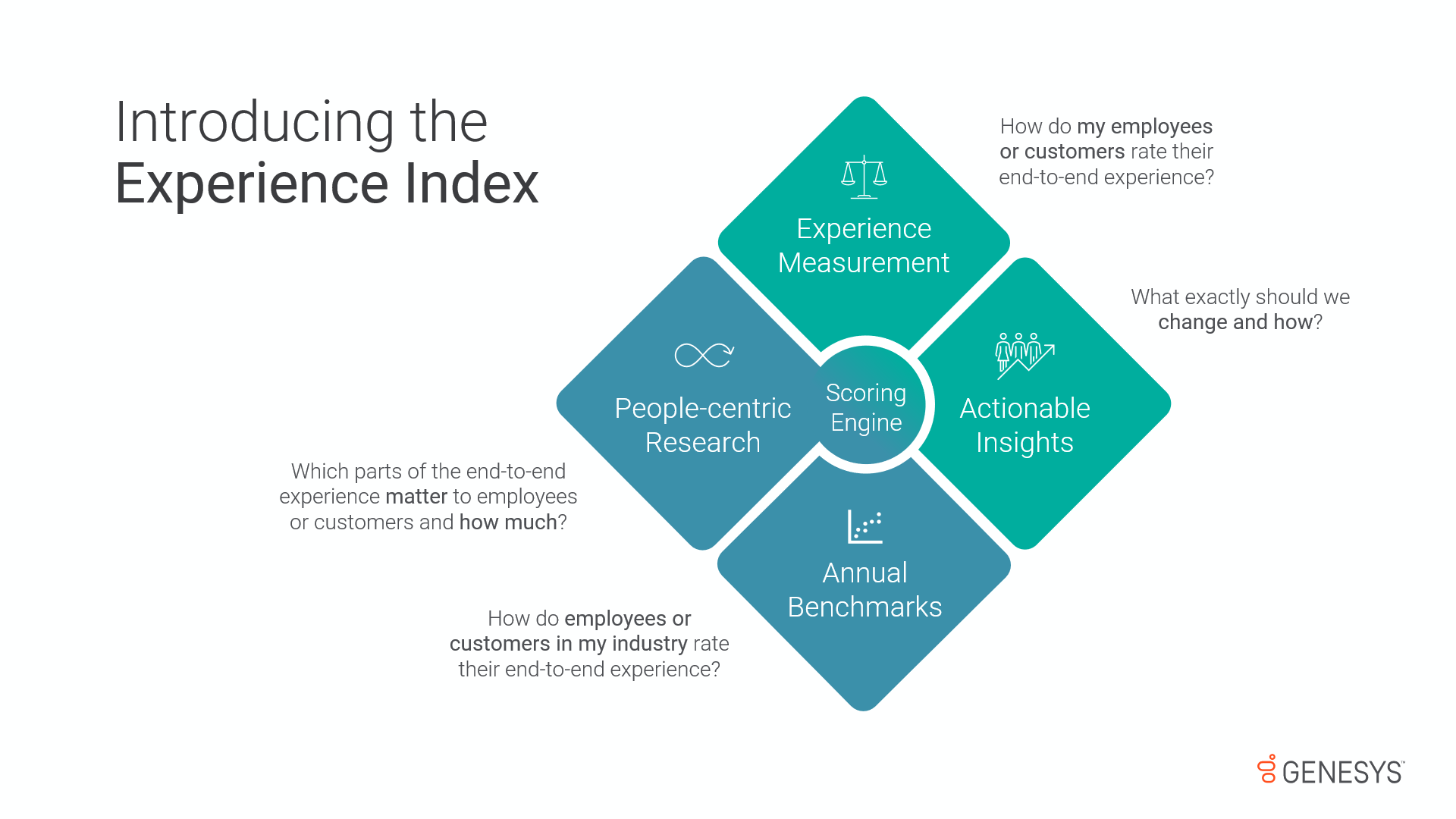In 2003, Fred Reichheld, a partner at Bain & Company, created the net promoter score (NPS). The metric is used in customer experience groups to measure the loyalty of a customer to a product or company.
Last month, No Jitter posted Dave Michels' "Organizations Should Focus on NPS," a piece enumerating the virtues of net promoter score and concluding, "As a single metric, NPS holds the key to growth and its impact is both straightforward and significant. There’s simply no need to add complexity or pay for advanced tools."
Within days of Michels' post about NPS, NTT published the latest edition of its decades-long industry benchmarking report, the 2023 Global Customer Experience Report. NTT’s press release title, "Investment in Employee Experience, Cloud and AI Drives Improved Customer Experience," highlights a prominent theme in customer experience today – the indelible link between employee and customer experience (EX and CX).
As seen in the graphic, 96% of the 1,442 CX and EX decision-makers and influencers respondents to the NTT survey -- from five countries in five global regions -- agree that CX and EX must be closely aligned to maximize enterprise growth. Yet almost as many respondents, 82%, agree that their employee experience levels are low, negatively impacting business success. The data says organizations know they have a problem but haven’t yet found a way to solve it.
Long-time contact center market leader Genesys to the rescue! Genesys recently released a new methodology – Experience Index -- designed to go beyond merely measuring customer sentiment. The Experience Index was developed to give organizations a clear understanding of the employee or customer’s journey, both good and bad, so that organizations can effectively course correct for better outcomes for everyone in the future. Genesys’ Experience Index has been years in the making. Peter Graf, chief strategy and operations officer, Genesys, first pre-briefed industry analysts on the still incubating project and its goals in November 2021. I remember being excited that the company was attempting to take on the challenge of measuring not just individual contact center interactions but the entire journey of an employee or customer, through multiple phases of a relationship with a company.
A year later, at a joint analyst and user gathering in Park City, Utah, in November 2022, Graf presented an update on the project in a small group setting to me and several Genesys customers. He explained that while Genesys has plans to develop the Experience Index for both agent and customer journeys, they were currently in trials solely with the agent aspect of the index.
I vividly recall an executive from a major US pharmaceutical company, after seeing the kind of information that was be delivered after an Experience Index engagement, saying, “Sign me up!”
The graphic below outlines the process Genesys undertook when creating the Experience Index and how it is then deployed with customers. The blue segments below indicate Genesys's holistic research, while the green segments show which parts of the Experience Index are applicable upon engagement with specific companies.
- People-centric Research: Genesys interviewed hundreds of contact center agents, managers, executives, and consumers to understand the essential elements of employee and customer journeys.
- Annual Benchmarks: Once Genesys determined which elements of an experience were the most important in driving overall sentiment; 23,000 contact center employees and consumers were surveyed across six industries to develop benchmarks. It is Genesys’ intention to update this survey data annually to account for anticipated shifts in scores based on industry and macro-economic conditions.
- Experience Measurement: This phase of the Experience Index process occurs with specific companies that have contracted for an engagement. The pre-built survey is sent to employees or customers of the firm to have them rate their experience.
- Actionable Insights: The ultimate step in an Experience Index project is a session that explains to the company what and how they can change in their operation to improve customer or agent experience and deliver positive business outcomes.
At Genesys Xperience 2023, the company’s annual user conference, held June 19-21, 2023, in Denver, Colorado, the Experience Index Offer for Contact Center Employees was officially launched, with availability for organizations in the US and EMEA starting in June 2023. Beyond merely overall satisfaction, the offer measures five phases of the agent experience: onboarding, work environment, customer interaction, well-being, employee engagement and development.
The Experience Index Offer for Contact Center Employees was described to me as a six-week customer engagement -- think consulting project -- which can be sold directly to customers or through partners to customers. In a pre-briefing, Graf also said that Experience Index has been used internally at Genesys for over a year to serve internal customer support teams.
An Experience Index engagement consists of multiple stages. I had the opportunity to speak with a pilot customer of the solution, a nationwide e-commerce retailer, so I will describe a typical project using that retailer’s experience.
- First, the customer worked with Genesys to do a personalized requirement review: This includes which demographic groups the company would like to survey and what data filters they would like to use, e.g., only employees that have been with the company at least X number of months or that work in certain locations. The retailer was interested in understanding why the performance of 1 of 4 business process outsourcers (BPO) differed dramatically from the rest.
- Then, the customer deployed the Genesys-designed survey: The agents and employees selected are then sent a link to complete the pre-built survey. The retailer reported that the completion rate for the survey was 90+%. “They definitely supported it (the survey) because they want to learn how they can get better as well,” the retail customer I spoke to reported.
- Finally, Genesys worked with the customer to come up with an action plan: An experienced advisory team digs into the data, highlights noteworthy results, and helps guide the customer to create a focused, tangible action plan. In the case of the retailer, one “a ha” moment uncovered was that, while still highly positive, the hybrid workforce was reporting the lowest overall experience – across the five phases of the employee experience measured -- of all groups.
Another finding, not previously identified by the retailer, was that voice agents reported a higher overall satisfaction than non-voice agent groups, e.g., chat or social teams. Knowing this, the retailer can build programs to address these specific groups to improve their agent experience. Graf explained that the company’s intention with the pricing for Experience Index was to make an engagement very affordable. As someone who also works as a strategic consultant to companies making CX decisions, I would equate the offer price to that of a small consulting engagement.
The Experience Index Offer for Contact Center Employees is not only available for Genesys customers. By making it available to companies using other contact center solutions – especially legacy premises-based systems. Genesys can use Experience Index as a sales tool to help prospective customers identify issues with their current solutions. The Experience Index team continues to work on a customer version of the methodology.












